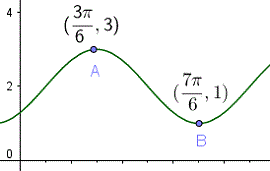Find the Period of Trigonometric Functions - Grade 12 Math
Explore Grade 12 trigonometry problems on finding the period of trigonometric functions from a graph or formula. Each question is accompanied by detailed, step-by-step solutions and explanations to help you understand the concepts clearly.
Question 1 - Period of a Sine Function
The graph below is that of a trigonometric function of the form \( y = a \sin(b x) \), with \( b \gt 0 \). Find its period and the parameter \( b\).

Locate two zeros that delimit a whole cycle or an integer number of cycles. In this example, we can see that from the zero at \( x = 0 \) to the zero at \( x = 1 \), there are two cycles. Hence the period \( P \) is equal to: \[ P = \dfrac{1 - 0}{2} = \dfrac{1}{2} \] We now use the formula for the period in terms of \( b \) and equate it to the value of the period found using the graph. \[ \dfrac{2\pi}{b} = \dfrac{1}{2} \] Solve for \( b \): \[ b = 4\pi \]
Question 2 - Another Sine Function
The graph of a trigonometric function of the form \( y = a \sin(b x) \), with \( b >0 \), is shown below. Find its period and the parameter \( b \).

There is one cycle from the zero at \( x = -\dfrac{\pi}{4} \) to the zero at \( x = \dfrac{\pi}{4} \). Hence the period \( P \) is given by: \[ P = \dfrac{\pi}{4} - \left(-\dfrac{\pi}{4}\right) = \dfrac{\pi}{2} \] We now equate the value of the period found using the graph to the above formula and solve for \( b \). \[ \dfrac{\pi}{2} = \dfrac{2\pi}{b}, \quad b = 4 \]
Question 3 - Cosine Function with Phase Shift
The graph below is that of a trigonometric function of the form \( y = a \cos(b x + c) \) with \( b \gt 0 \). Find the period of this function and the value of \( b \).

There are two zeros that delimit half a cycle. We first find these zeros.
Zero on the left: \[ \dfrac{-\pi/4 - \pi/8}{2} = -\dfrac{3\pi}{16} \] Zero on the right: \[ \dfrac{0 + \pi/8}{2} = \dfrac{\pi}{16} \] Hence half a period is equal to: \[ \dfrac{\pi}{16} - \left(-\dfrac{3\pi}{16}\right) = \dfrac{\pi}{4} \] And a full period \( P \) is equal to: \[ P = 2 \times \dfrac{\pi}{4} = \dfrac{\pi}{2} \] We now equate the value of the period found using the graph to the above formula and solve for \( b \). \[ \dfrac{\pi}{2} = \dfrac{2\pi}{b}, \quad b = 4 \]
Question 4 - Sine Function with Vertical Shift
The graph below is that of a trigonometric function of the form \( y = a \sin(b x + c) + d \) and points A and B are maximum and minimum points respectively. Find the period of this function and the value of \( b \), assuming \( b \gt 0 \).

The distance along the x axis between points A and B is equal to half a period and is given by: \[ \dfrac{7\pi}{6} - \dfrac{3\pi}{6} = \dfrac{2\pi}{3} \] The period \( P \) of the function is given by \[ P = 2 \times \dfrac{2\pi}{3} = \dfrac{4\pi}{3} \] \( b \) is found by solving \[ \dfrac{2\pi}{b} = \dfrac{4\pi}{3}, \quad b = \dfrac{3}{2} \]
Question 5 - Cosine Function with Given Minima
The graph of a trigonometric function of the form \( y = a \cos(b x + c) + d \) is shown below where points A and B are minimum points with x coordinates \( -0.3 \) and \( 0.1 \) respectively. Find the value of \( b \).

There is one whole cycle between points A and B. Hence period \( P \) is given by \[ P = 0.1 - (-0.3) = 0.4 \] \( b \) is found by solving \[ \dfrac{2\pi}{b} = 0.4, \quad b = 5\pi \]
Question 6 - Period of Given Functions
Find the Period of Each of the Following Functions
- \( y = \sin(x)\cos(x) - 3 \)
- \( y = 2 + 5\cos^2(x) \)
- \( y = \cos(x) + \sin(x) \)
- Use the identity \( \sin(2x) = 2 \sin(x) \cos(x) \): \[ y = \sin(x)\cos(x) - 3 = \dfrac{1}{2} \sin(2x) - 3 \] Period: \[ P = \dfrac{2\pi}{2} = \pi \]
- Use the identity \( \cos^2(x) = \dfrac{1}{2} (\cos(2x) + 1) \): \[ y = 2 + 5\cos^2(x) = 2 + 5\left(\dfrac{1}{2}(\cos(2x)+1)\right) = \dfrac{5}{2}\cos(2x) + \dfrac{9}{2} \] Period: \[ P = \dfrac{2\pi}{2} = \pi \]
- Rewrite: \[ y = \cos(x) + \sin(x) = \dfrac{2}{\sqrt{2}}\left(\dfrac{\sqrt{2}}{2}\cos(x) + \dfrac{\sqrt{2}}{2}\sin(x)\right) \] Using identity: \[ \sin\left(x+\dfrac{\pi}{4}\right) = \dfrac{\sqrt{2}}{2}\cos(x) + \dfrac{\sqrt{2}}{2}\sin(x) \] So: \[ y = \sqrt{2}\,\sin\left(x + \dfrac{\pi}{4}\right) \] Period: \[ P = \dfrac{2\pi}{1} = 2\pi \]
Question 7 - General Rule for Period of \( f(kx) \)
Suppose \( f(x) \) is a periodic function with period \( p \). What is the period of the function \( h(x) = f(kx) \), where \( k \) is a positive constant?
If \( p \) is the period of function \( f \), then \[ f(x+p) = f(x) \quad \text{for all } x \] Let \( x = kX \), where \( k \) is a constant: \[ f(kX+p) = f(kX) \] Rewrite as: \[ f\left(k\left(X+\dfrac{p}{k}\right)\right) = f(kX) \] Let \( h(x) = f(kx) \). Then: \[ h\left(X+\dfrac{p}{k}\right) = h(X) \] This indicates that \( h(x) = f(kx) \) is periodic with period \[ \dfrac{p}{k} \]